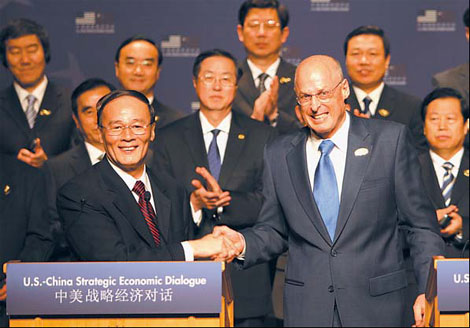Bilateral trade crucial to both nations
|
Chinese Vice-Premier Wang Qishan meets with US Treasury Secretary Henry Paulson during the fourth China-US Strategic Economic Dialog last month in Annapolis, Maryland. Yao Dawei/Xinhua |
Editor's note: In a recent interview with China Daily, Sarah E. Kemp, commercial counselor of the US Embassy in China, reviewed the two nations' bilateral business relations over the past few years.
Q: Could you comment on the overall China-US trade relationship? What role does China trade play in US global trade?
A: The US-China trade relationship has developed substantially over the past several years.
The US buys 70 percent of China's low-end consumer goods, while China has grown to become America's third-largest export market and continues to be one of the fastest-growing. American exports to China have risen by more than 188 percent since 2001, a rate that far outstrips its growth in imports. Total US-China trade rose from $5 billion in 1980 to $387.6 billion in 2007.
Of course, in absolute terms, the bilateral trade deficit with China is the US' largest, and a source of concern. But clearly, we both have a deep-rooted, common business interest in mutually developing our trade relationship.
China's economic development has had a constructive impact on our trade relationship. As Chinese living standards rise, Chinese demand for American goods and services has also risen.
US policy, across all administration divisions, seeks to engage China politically as well as economically as it moves toward market economics. US economic policies towards China have two major objectives: to help China progress to a rule-based system and to help China internationalize its economy.
Since joining the WTO, China's average tariffs have dropped from 41 percent to 6 percent and as a result, US exports have grown over 80 percent. Thus, China now has both the privileges as well as the responsibilities associated with membership in the international trading system. Indeed the trade relationship is a strong backbone and a stabilizing influence in the overall US- China relationship.
Foreign investment continues to play a crucial role in US-China relations as well as in the US economy, both as a powerful driver of the economy and a key source of innovation and exports. So we encourage Chinese investors to continue looking to the US for investment opportunities. It is our mission to promote inward investment and address national issues that may impede investment.
The "Go Global" strategy adopted by China has greatly contributed to the rapid growth of Chinese outbound investments. As such, Chinese companies have invested in the US by setting up representative offices, sales offices, mergers and acquisitions, and establishing joint ventures with US firms.
The US-China trade relationship has become fundamental to each country's economic interest as well as to maintaining a stable and prosperous global economic system. How we work together and cooperate on future bilateral and multilateral issues will have a considerable impact on the wellbeing of the global economy.
Exchange rate
Q: Continuing appreciation of the Chinese currency has brought difficulties to a large number of Chinese export companies and increased their costs, which may result in more expensive goods for US consumers. What is your view on maintaining trade balance and helping US consumers have access to less expensive quality goods?
A: In order for the US and China to maintain growth and productivity in the 21st century, the two nations must work side by side, reaching for common goals. Integral to these goals is addressing the individual challenges each country faces.
Exchange rate reform is a critical issue for China and if handled properly, will redirect growth to domestic consumption. While the yuan has appreciated against the dollar by nearly 20 percent since 2005, a more flexible rate will help China address its short and medium-term challenges. I believe these challenges can be addressed and very much look forward to the US and China continuing its strong relationship.
Investing in the US

Q: A growing number of Chinese companies are willing to invest in the US. What suggestions do you have for potential investors?
A: As a place to invest, the United States provides a stable and rewarding market. Outstanding infrastructure, low taxes and a transparent legal system help foreign investors reach the world's "most lucrative consumer market". Incoming foreign investment plays a key role in the US economy and is welcomed and encouraged.
Like the US, China realizes that its "development cannot be achieved in isolation from the world", as Wu Yi, former Chinese vice-premier said on September 8, 2007. Since China adopted a "Go Global" strategy in 2002, their outbound investment experienced rapid growth - fully 60 percent average annual growth in non-financial overseas investment from 2002 to 2006.
There's still more room to grow however. A recent study by Mckinsey & Co shows that most of China's Top 500 companies have not made any overseas investments. In fact, in China's most active sectors such as technology, media and telecoms, only 50 percent of large companies have invested abroad. It is beneficial to both the US and China for China's growing investment trend to continue. Clearly, foreign investment will play a significant role in US-China relations and as such, we strongly encourage Chinese investors to continue looking towards the US.
Increasing visits
Q: Do you think it is necessary to increase visits by government officials and company executives to help promote trade and investment between the two countries?
A: Visits between government officials and company executives are becoming increasingly essential in trade and investment promotion between the US and China. Continuing our dialogue with China through the US-China Strategic Economic Dialog (SED) remains a crucial element in developing our economic relationship.
The SED, established by US President George W. Bush and Chinese President Hu Jintao in September 2006, has made it possible for both the US and China to develop enduring, strategic solutions in dealing with issues of urgent concern in our economic relationship.
By prioritizing issues in the more general context of our economic relationship, the SED helps provide direction and creates enduring momentum for the many already existing bilateral mechanisms we use to foster cooperation and resolve concerns of various economic issues. For example, the SED can help create more accountable business ties as both parties are placed on a level playing field.
The SED provides an additional medium to advance our trade as well as a means to maintain strong and mutually beneficial economic and trade relations between the US and China.
Tourism destination
Q: The US has become a tourism destination for Chinese citizens. What's the role of tourism in the China-US trade relationship?
A: Over the past few years tourism has taken on a significant role in the China-US trade relationship. In 2007 China ranked as the 16th largest international tourism market for the United States, with over 397,000 Chinese visitors to the US. This marks a 24 percent increase from 2006 and an incredible 59 percent increase from 2000.
Tourism, in general, is beneficial to all nations as it introduces each country's respective culture in ways that television, film and other media never can. As such, we are extremely pleased to see this remarkable rise and are excited about the future prospects for Chinese tourism to the United States.
With the recent signing of an agreement on group travel to the US, we believe tourism, and consequently the trade relationship, between the US and China will continue to make great strides. Chinese citizens now have more options and may choose to travel with packaged tours if they wish. We will continue to make Chinese tourism to the US as convenient as possible and look forward to an increasingly strong US-China trade relationship.
(China Daily 07/04/2008 page23)















